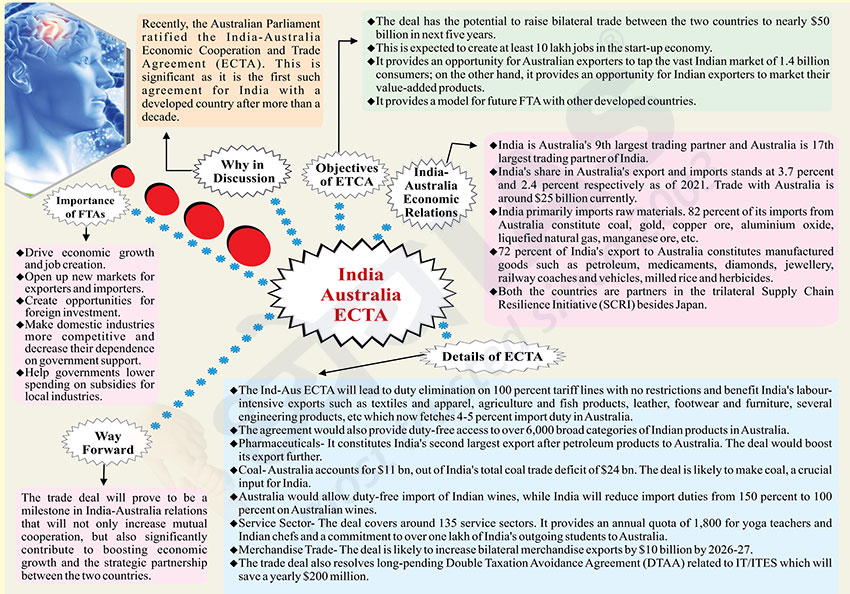Brain-booster /
14 Dec 2022
Brain Booster for UPSC & State PCS Examination (Topic: India-Australia ECTA)

Why in Discussion?
- Recently, the Australian Parliament ratified the India-Australia
Economic Cooperation and Trade Agreement (ECTA). This is significant as it
is the first such agreement for India with a developed country after more
than a decade.
Objectives of ETCA
- The deal has the potential to raise bilateral trade between the two
countries to nearly $50 billion in next five years.
- This is expected to create at least 10 lakh jobs in the start-up
economy.
- It provides an opportunity for Australian exporters to tap the vast
Indian market of 1.4 billion consumers; on the other hand, it provides an
opportunity for Indian exporters to market their value-added products.
- It provides a model for future FTA with other developed countries.
India-Australia Economic Relations
- India is Australia's 9th largest trading partner and Australia is 17th
largest trading partner of India.
- India's share in Australia's export and imports stands at 3.7 percent
and 2.4 percent respectively as of 2021. Trade with Australia is around $25
billion currently.
- India primarily imports raw materials. 82 percent of its imports from
Australia constitute coal, gold, copper ore, aluminium oxide, liquefied
natural gas, manganese ore, etc.
- 72 percent of India's export to Australia constitutes manufactured goods
such as petroleum, medicaments, diamonds, jewellery, railway coaches and
vehicles, milled rice and herbicides.
- Both the countries are partners in the trilateral Supply Chain
Resilience Initiative (SCRI) besides Japan.
Details of ECTA
- The Ind-Aus ECTA will lead to duty elimination on 100 percent tariff
lines with no restrictions and benefit India's labourintensive exports such
as textiles and apparel, agriculture and fish products, leather, footwear
and furniture, several engineering products, etc which now fetches 4-5
percent import duty in Australia.
- The agreement would also provide duty-free access to over 6,000 broad
categories of Indian products in Australia.
- Pharmaceuticals- It constitutes India's second largest export after
petroleum products to Australia. The deal would boost its export further.
- Coal- Australia accounts for $11 bn, out of India's total coal trade
deficit of $24 bn. The deal is likely to make coal, a crucial input for
India.
- Australia would allow duty-free import of Indian wines, while India will
reduce import duties from 150 percent to 100 percent on Australian wines.
- Service Sector- The deal covers around 135 service sectors. It provides
an annual quota of 1,800 for yoga teachers and Indian chefs and a commitment
to over one lakh of India's outgoing students to Australia.
- Merchandise Trade- The deal is likely to increase bilateral merchandise
exports by $10 billion by 2026-27.
- The trade deal also resolves long-pending Double Taxation Avoidance
Agreement (DTAA) related to IT/ITES which will save a yearly $200 million.
Importance of FTAs
- Drive economic growth and job creation.
- Open up new markets for exporters and importers.
- Create opportunities for foreign investment.
- Make domestic industries more competitive and decrease their dependence
on government support.
- Help governments lower spending on subsidies for local industries.
Way Forward
- The trade deal will prove to be a milestone in India-Australia relations
that will not only increase mutual cooperation, but also significantly
contribute to boosting economic growth and the strategic partnership between
the two countries.








